Family : Cytinaceae

Text © Prof. Pietro Pavone

English translation by Mario Beltramini
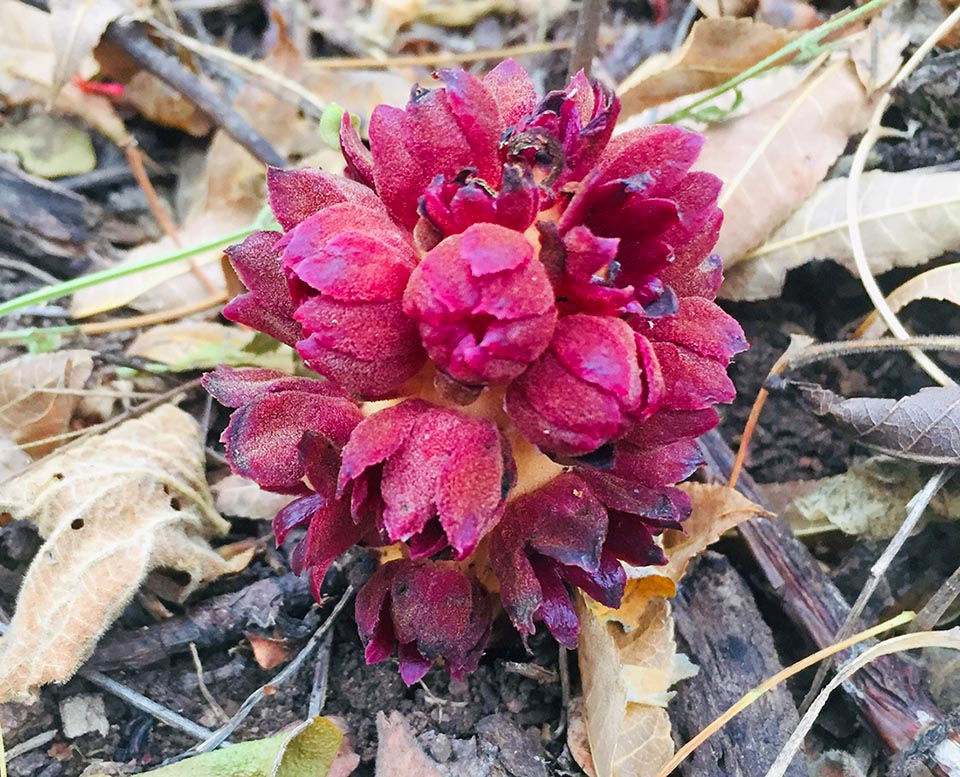
Bdallophytum americanum is a holoparasitic plant, unable of photosynthesis. It develops inside the roots of the host plants, whilst emerge only the flowers and the fruits © David Valenzuel
Bdallophytum americanum (R.Br.) Eichler ex Solms is an obligate parasite plant (holoparasite) lacking the ability to photosynthesize, belonging to the family Cytinaceae A.Rich. of the order Malvales.
In the past the family was included in the order Rafflesiales but molecular studies have indicated its nesting inside the order Malvales (APG III, 2009).
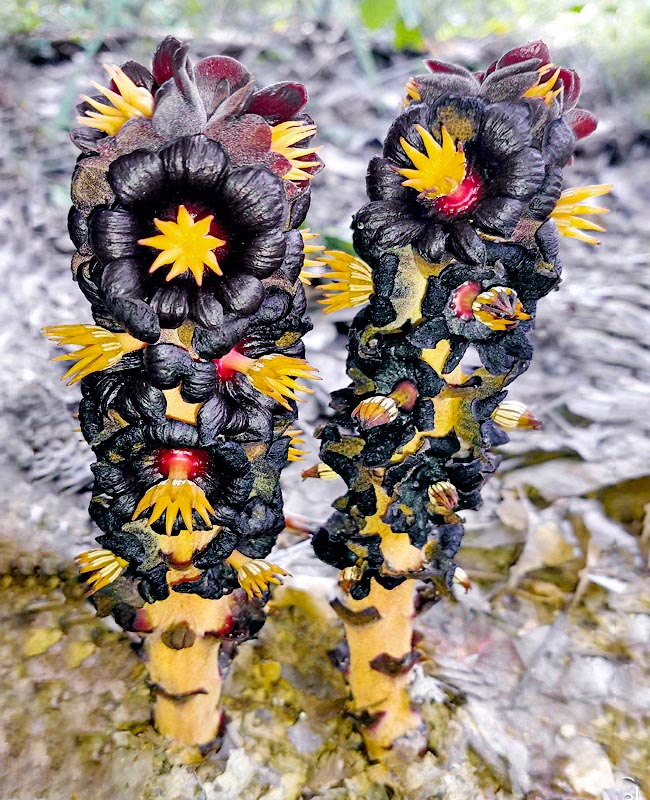
It’s a dioecious species with male and female flowers. The male have the perigonium varying from cherry red to black. Stamens are monadelphous with white anthers and sharp appendages of yellowish connective tissue © Eduardo Axel Recillas Bautista
Bdallophytum americanum, is found in the tropical biome seasonally dry, mainly in the vegetation of the tropical deciduous forests, evergreen and sub deciduous and xerophilous shrub, from 80 to 1840 m ASL.
Its distribution range stands from Mexico to Central America (Costa Rica, El Salvador, Guatemala, Honduras, Mexico, NIcaragua).
It’s a parasite of various species of Bursera, like Bursera simaruba (L.) Sarg., but also of Gyrocarpus americanus Jacq., Haematoxylum brasiletto H. Karst., as well as species of Cochlospermum Kunth, Ficus L. and Guazuma Mill.
Initially, this species was called by Robert Brown (1773-1858) Cytinus americanus R. Br (Trans. Linn. Soc. London, prepr. 19: 246, 1845) and represented the first report in America of a genus of holoparasitic plants known only in the Old World.
Later on Frederik Michaek Liebmann (1813-1856) did call it Scytanthus bambusarum Liebm. (Förh. Skand. Naturf. Möte 4: 183 (1847) without however linking it to the genus Cytinus L.
However Scytanthus is not a valid name being an orthographic variant of an already used name Skytanthus Meyen (Reise Erde 1: 376 (1834), genus of the family Apocynaceae.
Afterwards, August Wilkhelm Eichler (1839-1887) proposed the genus Bdallophytum (Bot. Zeitung (Berlin) 30: 709, t.8, 1872) with only two species (Bdallophytum andrieuxii Eichler and Bdallophytum ceratantherum Eichler) without taking into account the other species previously described.
In 1889, Hermann zu Solms-Laubach (1842-1915), in H.G.A.Engler & K.A.E.Prantl, Nat. Pflanzenfam. 3(1): 282 – 1889), described the genera of the family Rafflessiacae including there Cytinus L. and Bdallophyton Eichl., erroneous variant of Bdallophytum.
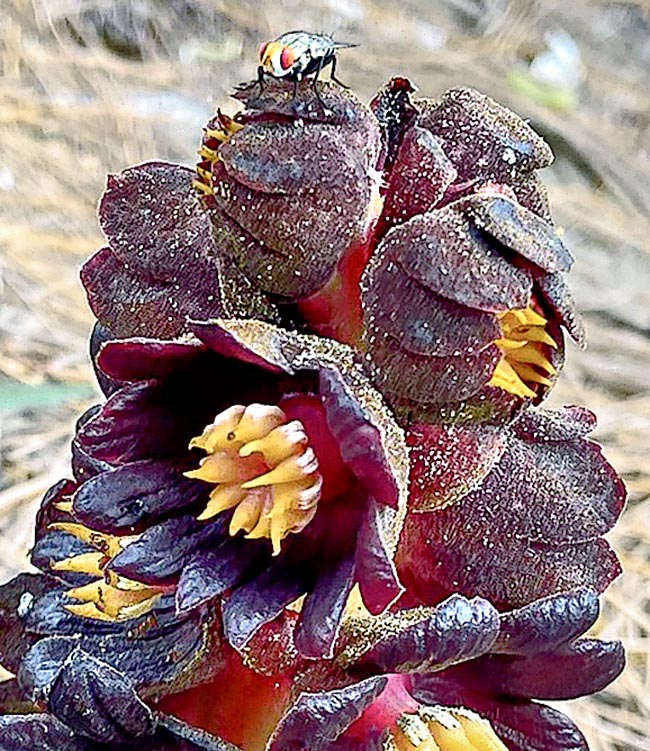
The appendages, with tips touching at the centre protruding from perigonium when the flower opens, then get a stellar look. Here on top we note the Carrion fly, a pollinator attracted by the fetid odour and by the nectar © juanbgodoy9
Only in the XX century all American species were included into the genus Bdallophytum.
This genus, together with the genus Cytinus, was placed inside the family Raflesiaceae, as a tribe: Cytineae.
This position inside the Raflesiaceae, was maintained for long time, but the utilization of nuclear and mitochondrial molecular markers in the phylogenetic analysis has revealed that this position is to be considered as artificial because based on converging characters such as: the endoparasitism, the reduction of the vegetative structures, the similarity of the reproductive organs.
Therefore all taxa for the former tribe Cytineae, have been excluded from the Raflesiaceae and included into the new family Cytinaceae, in turn related with the family Muntingiaceae of tropical America.
Thanks to this evidence and affinities the family Cytinaceae has been included in the order Malvales.
The name of the genus derives from ancient Greek “βδάλλω” (to suck) and “ϕυτόν” (phyton) plant. The specific epithet americanum refers to its area of origin.
Common names. In Mexico, in the state of Guerrero, this species is called “flor de tierra”. In the city of San Luis Potosí (Mexico),”boo’waat wits”. American Bdallophytum.
The vegetative parts of Bdallophytum americanum are filamentous, similar to fungal hyphae, and develop inside the roots of plants of the genus Bursera, such as Bursera simaruba (L.) Sarg. (Burseraceae) to emerge only for the production of the flowers and of the fruits. They are small herbaceous plants, fleshy, glandular, 8-15 (-25) cm tall, and dioecious.
The stems, not ramified, emerge from the host plant and are of dull yellow colour when young and then vary from cherry red to purple, covered by multicellular claviform hairs.
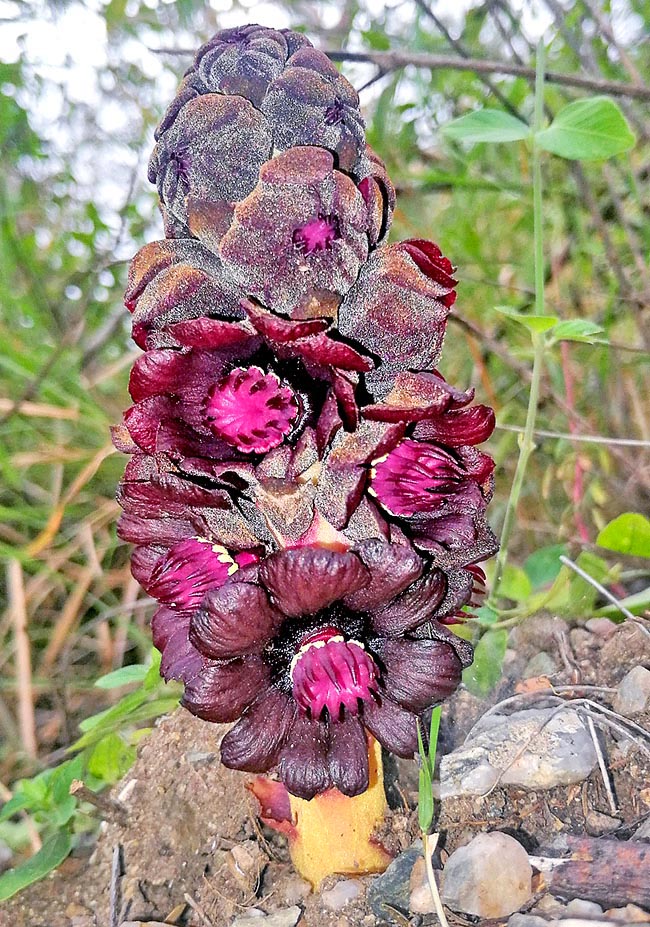
The appendages tending to red, closing, inform pollinators that the pollen stocks are ending © Rogelio Aguilar Tapia
The leaves, arranged in irregular bundles of three, are reduced to 0,5-1,5 x (3,4-) 4,5-6,3 mm scales, ovate-lanceolate, elliptical or spatulate, with brown serrated margins.
Usually the inflorescences have 9-12 flowers arranged over the bracts.
When young the flowers are velvety and of purple colour.
The male flowers have 6-9 segmented perigonium, 6,5-10,9 mm tall, with diameter at the base of 5-6,4 mm, of cherry red to black colour.
The stamens are monadelphous and the filaments are merged in a 1,4-2,7 (-3,5) mm long column.
The usually straight anthers, of white colour, form a ring at the apex of the column, with appendages of connective tissue, 2-4,5 mm long, pointed, of yellowish colour that contrasts with that of the perigonium.
The female flowers have perigonium with 7-9 segments, (4,7-) 5,8-11 mm of height, 4,5-8,5 mm of diameter at the base, of cherry red colour, with straw yellow styles at the anthesis, 3,5-6,5 (8) mm long and 2 mm thick at the base.
The stigmas are 9-10 lobate, pad-shaped with radial margins and slight central depression, of yellow colour.
The ovary is yellowish and with hairs, inferior, unilocular with many ovules.
The ovules are orthotropic, like in Cytinus, and with only one integument.
The style is very short with one very evident capitate stigma, lobate and of whitish to yellowish colour, attractive for the pollinators.
Blooming occurs mainly from April to August and the fruitification from August to November.
“J Plant Res 136, 643-655 (2023)” field observations on the floral biology and on the rôle of the staminal appendages have highlighted their changes throughout the life of the single flower.
Initially the appendages have the tips touching at the centre, at the opening of the flower, protruding from the perigonium, then they open as the flower blooms, until to get a complete opening suitable for the landing of the pollinators.
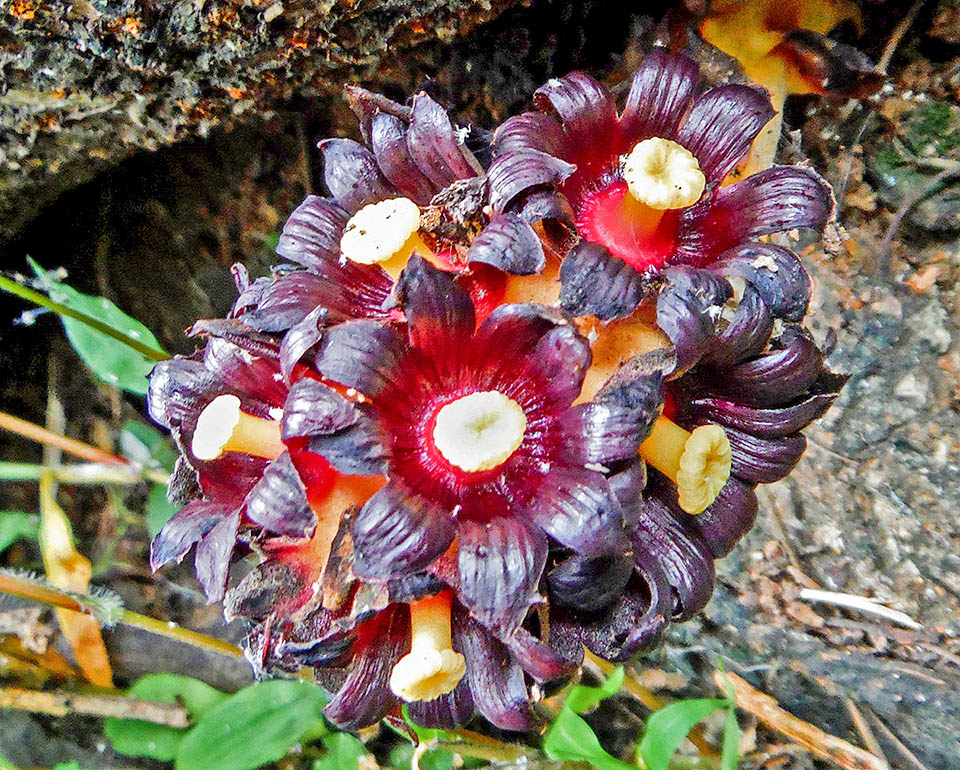
Also female flowers change over time. Initially of pale red colour, become then dark for attracting the attention on their candid stigmas © Chris Lloyd
The colour of the flower is dark red and contrasts with the whitish color of the staminal appendages, when completely open.
It has been noted that during the first two days of anthesis,the pollen is at its greatest vitality. But, when the appendages begin to close going back to their initial position (third day of anthesis), the vitality of the pollen drops sharply. Therefore the pollen grains are vital in the male flowers during the first 4 or 5 days of their opening.
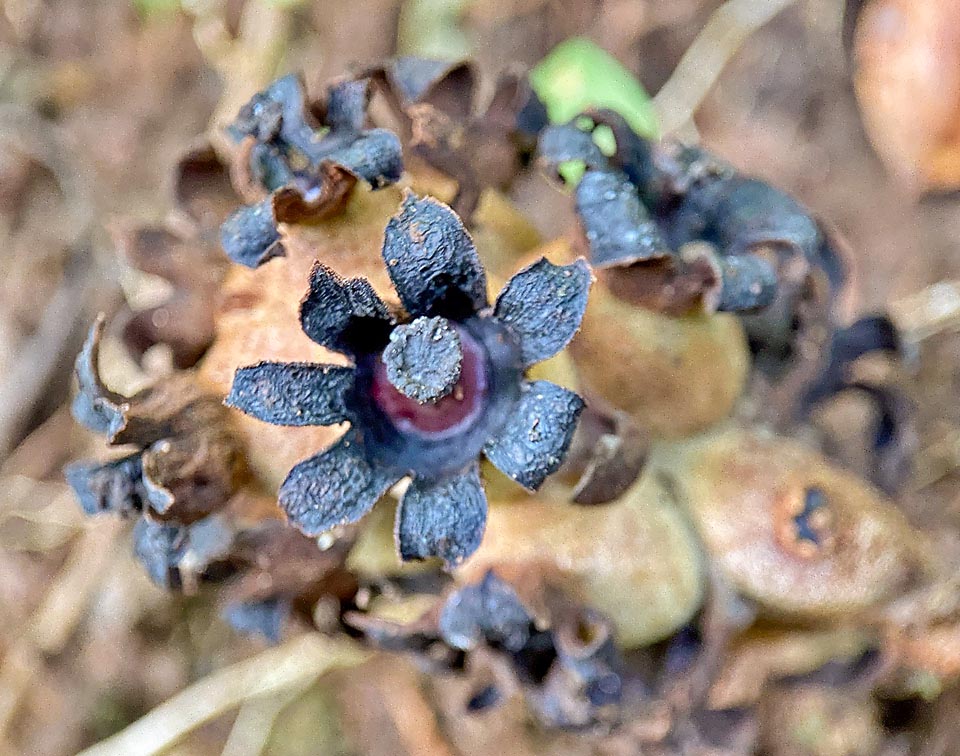
Around the fifth day from anthesis the perigonium withers getting very dark shades © Carlos Funes
Also the female flowers show changes over time. At the beginning, they are of pale red colour and get darker as days go by.
The perigonium withers by the fifth day, indicating the beginning of the development of the fruit if fecundation has occurred.
The male inflorescences emerge before the female ones and all male and female flowers open during the day and keep open also during the night.
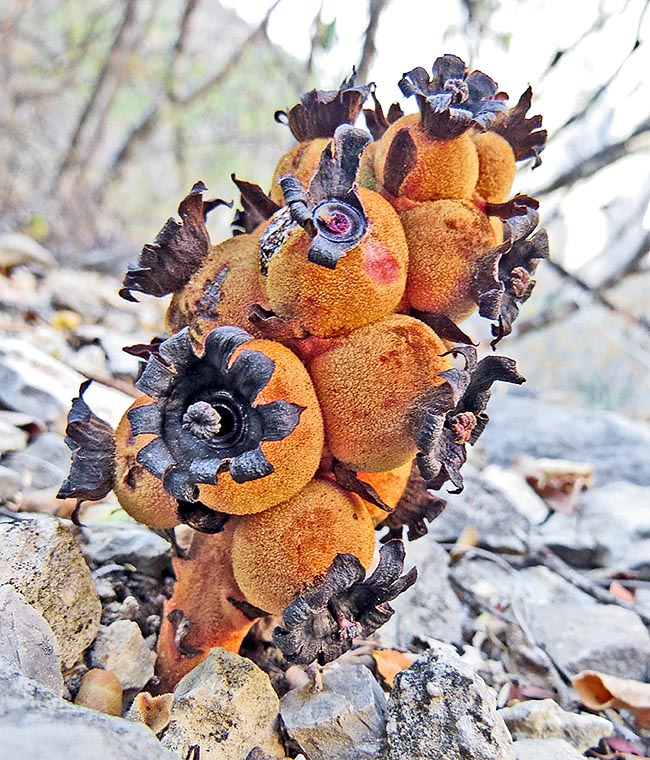
Then, if the fecundation did occur, ovaries get larger. The fruits, with glandular hairs, contain several seeds © Leticia Soriano Flores
The pollination is done by Syrphids, to a lesser extent by other pollinators like bees, beetles and carrion flies attracted by the odour of the flowers and by the nectar as reward.
The pollinators, once placed on the stigmas or on the connective appendages, depending on the sex, move to visit the flowers along the same inflorescence taking less time than on the female flowers.
The fruits are globose berries of 1,2-1,5 cm of diameter, at times merged, densely covered by glandular hairs of purple colour, containing numerous 0,4-0,5 long seeds.
The seeds are very small, covered by mucilage.
Their dispersion is done by the rodent Peromyscus mexicanus (Saussure, 1860) and by the leafcutter ants of the genus Atta (subfamily Myrmicinae).
In the laboratory it was seen that the germination of the seeds occurs only if are present particular chemical substances emitted by the host plant (Acta Botanica Mexicana 87: 1-21 (2009).
The chromosome number of Bdallophytum americanum is 2n=24.
In some rural Mexican areas Bdallophytum americanum is utilized by the local populations for treating fever, headache and stomach pain.
Synonyms: Bdallophytum bambusarum (Liebm.) Harms (1935); Bdallophytum ceratantherum Eichler (1872); Cytinus americanus R.Br. (1844); Hypocistis americana (R.Br.) Kuntze (1891); Scytanthus americanus (R.Br.) Solms (1901); Scytanthus bambusarum Liebm. (1847).
